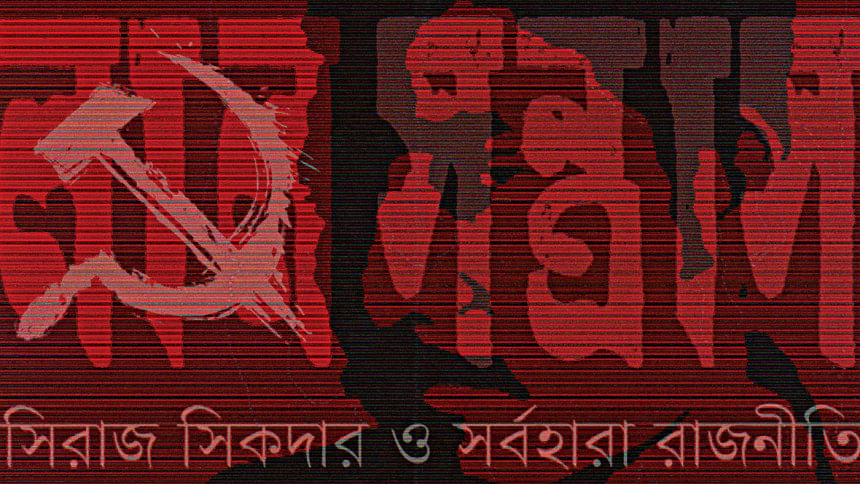Red terror or revolutionary war?

Lal Shontrash: Siraj Sikder O Sarbahara Rajneeti (Baatighar, 2021) is about the birth, growth, and withering away of a revolutionary organisation about which most Bangladeshis have heard and very many are curious. Given the clandestine character of the short-lived Purba Banglar Sarbahara Party and the turbulent times in which it existed, very little information about this organisation had been available until now. What was hitherto known was in bits and patches, as a bewildering mixture of fact, myth, and fiction.
The party's leader, Siraj Sikder, acquired cult status in his lifetime and turned into a mythical figure after his death in police captivity in 1975 at the rather young age of 30. Compounding the curiosity are the circumstances of his death, which are as controversial as his revolutionary life. In light of this, writer and researcher Mohiuddin Ahmad has taken upon himself a very challenging task and it must be said that he has acquitted himself rather well.
A political historiographer and noted Prothom Alo columnist, who formerly served as Assistant Editor at the Daily Ganakantha, Ahmad has previously written about the political histories of Awami League, BNP, JASAD, and the events of "1/11". As with these previous books, Lal Shontrash is a gripping historical account from beginning to end, a real life story of some naïve young men and women barely in their adulthood coming together under Sikder's leadership to liberate the oppressed and exploited people of Bangladesh through armed struggle.
The book consists of two parts. The first is a summary of the Leftist politics, parties, and movements in East Bengal (Bangladesh), in general, and of the Sarbahara Party, in particular. In the second part, Ahmad publishes the accounts of 11 party activists based on interviews published, unpublished, and some conducted by the author himself.
Published for the first time, for instance, is a written testimony by Bulu, who was not only active in the party for many years but also was married to Taher, Sikder's closest comrade and deputy until his assassination in August 1971. As such, the value of Bulu's testimony lies in the fact that it is a contemporary, first-hand account straight from the heart and never intended for publication.
Some of the facts explicitly mentioned or implied in Bulu's testimony are explosive and certain to invite the wrath of Sikder devotees, particularly his multiple marriages and alleged extra-marital liaisons and advances. But the fact is that these unsavoury truths about Sikder are corroborated elsewhere; they are neither a figment of the author's imagination nor an effort to vilify the late leader.
The other accusations against Sikder, that of autocratic leadership and a personality cult, which brooked no criticism and led to harsh expulsions and even assassinations, are quite well known. It was this tendency that resulted in a murderous rampage within the party after the supremo's death. Comrades accused fellow comrades of betrayal and some were executed after summary "show trials", leading to a meltdown of the party.
Continuous hardships, secretiveness, violence, and repression cumulatively resulted in dissension and deterioration within the party, aggravated by Sikder's sudden death in January 1975. Ahmad has provided the best available details of the circumstances of Sikder's capture and death from four different sources, three published and one based on an interview the author conducted with a then-serving high official of Rakkhi Bahini.
Very helpfully, Ahmad also provides in his book a list of names of party activists along with the pseudonyms by which they were known within the party. However, although he provides a list of his sources in an appendix, the lack of proper citations in the text often leaves the reader confused. It might have been useful to provide a full chronological list of the party congresses, conferences, and meetings in an appendix for ready reference.
There are also a few inaccuracies and mistranslations which the author ought to rectify in future editions. For example, he mentions that the party's magazine Lal Jhanda ("Red Flag") was first published in September 1974. I am able personally to attest to the fact that the first issue was published sometime in mid to late 1969. It was clandestinely cyclostyled late one evening in an architect's office in Topkhana Road in Dhaka, where Bulu's brother Kalam worked. Being a party sympathiser, he had provided party cadres the key to the office. The word "jhanda" was chosen after some deliberation, being preferred (by Sikder himself) over the more authentic Bangla synonym "potaka". ("Jhanda" resonated militancy, whereas "potaka" sounded too gentle!)
Many admirers of the party and its leader, among other things, will perhaps protest the title of Ahmad's book, which translates to "Red Terror"; but it is neither misleading nor inaccurate. Sarbahara Party cadres, like all revolutionaries throughout history, had no scruples against employing terror, and even execution, against those they perceived as enemies and traitors, including their own.
After all, Sikder and his followers—devotees of the revered Chairman Mao Zedong—were self-professed believers and practitioners of "armed struggle, class war, people's war and revolutionary terror". It is too early to say how history will judge Siraj Sikder and his Sarbahara Party. But this book is a very commendable effort on the part of Mohiuddin Ahmad to preserve the record for future historians to work with.
Razi Azmi was involved with the Sarbahara Party in its formative years. He is a former academic with a doctorate in modern history.
Email: [email protected]

 For all latest news, follow The Daily Star's Google News channel.
For all latest news, follow The Daily Star's Google News channel. 



Comments